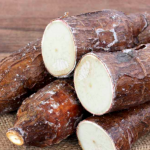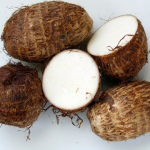August 8, 2023
Here we are again–traipsing through the summer reruns as I get ready for my October Creative Cafe: Food & Writing class for UCLA Extension’s Writers’ Program. For more on that, visit “classes” on this page for a clickable link to a full description and registration. I’m excited to be doing it over four Saturdays in October, providing students more time to develop their work with revisions and critique than we’ve been able to previously do when confined to two weekends. This re-post is from April, 2020, written in the first few weeks of those dark covid days about the adventures to be found in Ralph’s empty produce bins.
 In Part I of What’s Eating Us, first posted May, 2017, I revisited Northern California’s food scene circa the 1970s and ’80s, while contemplating our current irksome eating habits. Restaurant dining had come to feel like an extreme sport with dishes competing for Instagram fame while table talk was lost to a brutal din. To top it off, It seemed no one was cooking real food at home. My solemn advice at the end: “we could all benefit by tuning our senses back to the subtleties of truly great food.” I suggested revisiting farmers’ markets for inspiration, returning to our kitchens and reminding ourselves of the adventures waiting there. I further suggested going to restaurants where the guests are made to feel as exciting as the food. I suggested such simple steps might return us to “the humanity and civility of yore, or even the ’70s, where that food revolution began, at the table and in the kitchen.”
In Part I of What’s Eating Us, first posted May, 2017, I revisited Northern California’s food scene circa the 1970s and ’80s, while contemplating our current irksome eating habits. Restaurant dining had come to feel like an extreme sport with dishes competing for Instagram fame while table talk was lost to a brutal din. To top it off, It seemed no one was cooking real food at home. My solemn advice at the end: “we could all benefit by tuning our senses back to the subtleties of truly great food.” I suggested revisiting farmers’ markets for inspiration, returning to our kitchens and reminding ourselves of the adventures waiting there. I further suggested going to restaurants where the guests are made to feel as exciting as the food. I suggested such simple steps might return us to “the humanity and civility of yore, or even the ’70s, where that food revolution began, at the table and in the kitchen.”
Well, look at us now, April, 2020. The world is in global pandemic quarantine, the restaurants have all closed and folks have been forced back into their kitchens. Most all of those inspirational farmers’ markets have been shut down until further notice. Anyone over 65 is taking their life in their frequently washed hands shopping in a supermarket. We are lucky if we can snag a home delivery and what gets delivered is often the luck of the draw. We are making do and making up our menus as we go along.
Personally, I’m enjoying that part of this otherwise painful and challenging time. I am hunkered down in Oxnard, an agricultural beach community, with my older sister, my husband and my dog. My last trip to Ralph’s was Sunday, March 15, about 30 minutes after the governor ordered all citizens over the age of 65 to stay home. My sister had been jonesing for the Ralph’s tangerines she virtually lives on (along with tortilla chips, her T Diet) and I thought I’d get out before word spread and senior arrests began. Inside the supermarket I was hit with our new reality: shelves empty of paper products and cleaning supplies. The bins of the most popular produce items were empty, as well, leaving the more mysterious ones to explore.
A man stood by the specialty section, where the odd things I can’t often name bide their time. He was laughing. I caught his glance, was touched by his humanity–a light heart in the midst of this grim scene. He was looking right at me and I wanted to ask him what was so funny? Then I noticed he was holding a dark, long, fat stick like thing, some kind of a root or tuber. I hesitated: the last old guy who tried to strike up a conversation with me in a produce aisle made a lewd comment about a cucumber. I didn’t let that stop me this time. Everyone was on edge. I could use a laugh. So, I asked.
“I was just over at the potatoes,” he said. “They’re all out, but nobody’s bothered with these and they’re just as good.” “What are they?” I asked. “I’m not sure.” “Taro root, maybe?” I offered. “Maybe,” he said, with a shrug, “I’m not sure.” I knew vaguely of taro, but had never done anything with it. Poi, that much maligned luau offering was the only dish that came to mind. “What are you going to do with them?” I asked. “Boil them, steam them, eat them like potatoes.” And it started with a T, maybe my sister would eat it. Sold! I grabbed a couple and tossed them in the cart.
Long story short, I got them home, did some taro root research, saw warnings about handling them raw (something in the dark brown outer peel irritates skin) and cooking them could leave a tough to get off sludge on pans. Plus, no online recipe sounded worth bothering with. Cakes, mashed, chips? The simplest was the furthest I was willing to go: boil them for an hour and a half. Promising to get back to them, I put on rubber gloves, broke them into multiple pieces, tossed them in a bag and threw them in the back of the fridge.
 I had better things to do. We had discovered two open, bounteous produce stands entirely absent of crowds at the edge of Oxnard’s farm fields. Our cache of fresh fruits and vegetables included pineapples and a pineapple corer. I hadn’t eaten fresh pineapple since the ’70s. Too much trouble, too sweet, etc. But, now that I am avoiding refined or added sugar, AND I have my $2 stainless steel corer, I’ve decided pineapple is nothing less than a gift from the gods (and Costa Rica). My best invention yet: baked plantains (also from said produce stand) doused with lime juice and a finely minced gremolata of fresh pineapple and black garlic. The black garlic was another Ralph’s find, I stumbled upon it by the taro root. I thought it was a new variety of garlic that grew black. No, it’s a fermented item, 3 weeks in low heat, turns it black with a sweet taste like roasted garlic and molasses. It can go either sweet or savory, as can plantains, as can pineapple, et voila! Pandemic cooking at its finest.
I had better things to do. We had discovered two open, bounteous produce stands entirely absent of crowds at the edge of Oxnard’s farm fields. Our cache of fresh fruits and vegetables included pineapples and a pineapple corer. I hadn’t eaten fresh pineapple since the ’70s. Too much trouble, too sweet, etc. But, now that I am avoiding refined or added sugar, AND I have my $2 stainless steel corer, I’ve decided pineapple is nothing less than a gift from the gods (and Costa Rica). My best invention yet: baked plantains (also from said produce stand) doused with lime juice and a finely minced gremolata of fresh pineapple and black garlic. The black garlic was another Ralph’s find, I stumbled upon it by the taro root. I thought it was a new variety of garlic that grew black. No, it’s a fermented item, 3 weeks in low heat, turns it black with a sweet taste like roasted garlic and molasses. It can go either sweet or savory, as can plantains, as can pineapple, et voila! Pandemic cooking at its finest.
My sister wouldn’t touch it, of course, nothing on the plate started with a T.
Last Friday night it was TGIF and what sounded truly exciting after a couple of weeks of self isolation? How about boiling taro root! Besides, all the pineapples and plantains were gone. So, an hour later my taro were tender, splitting open like ecstatic sea cucumbers in their brown roiling waters, and decidedly done. I don’t know what would have happened if I’d given them the extra 30 minutes as instructed. I didn’t bother tasting them, it was late, I’d already eaten, and they frankly didn’t look so good–fibrous, white and blah. The thought occurred that the man in the produce section might be home laughing at me, the woman he got to buy taro root a couple of weeks ago.
Back in the fridge they went. The pot soaked overnight and took some serious scrubbing to get the schmutz off. Then it was time for the tasting. I removed the dark, bark like skin and put the white chunks on a plate. Into the microwave, 30 seconds or so, doused them with butter, salt, sour cream and a sprinkling of green onions. YES–they do taste like potatoes! And like all great potatoes, they are the perfect neutral medium for all sorts of things. Maybe even a fine dice of black garlic and pineapple.
But you know what was the most surprising thing of all? It wasn’t really taro root. When I looked for an image to post, all the taro shots were of stubby, squat tubers. The long, thin guys were tapioca! Or maybe they were cassava, or maybe even yuca. It’s hard to tell, the names seem interchangeable, I guess it depends on where you’re coming from and you go figure! If it’s ever safe to go back to Ralph’s, I’ll ask them what they call it. Whatever it is, I can vouch it’s a fine substitute for potatoes, just like the laughing man said. 
Taro Root
